
Testing is an essential part of any learning process in education, but sometimes teachers and examiners don’t get the answers they expect. The following test answers range from clever plays on words and geometrical designs interpreted as Pac-Man, to bizarre drawings and new revelations about giraffes.
Whether these student responses were born of desperation or pure sassiness, the results are undeniably hilarious. And although the students’ inventiveness didn’t always earn them credit, the answers offer a fascinating look at some of education’s quirks, while also raising interesting questions about examinations and creativity. Best of all, though, they bring a smile to one’s face!
10. This boy is…
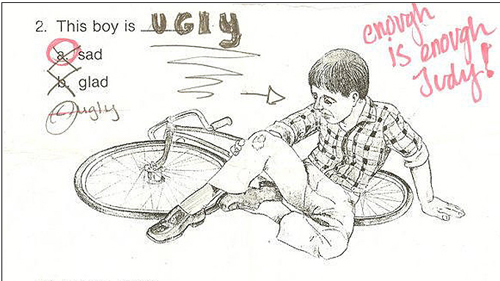
The boy in this picture may be sad, but for Judy, his emotional state was a moot point. It’s easy to imagine a cheeky girl staring at the picture with revulsion. For her, the boy’s physical features far outweighed the importance of his emotions – scraped up knee or not. While Judy could have easily chosen “a” based on the boy’s crashed bike, injured knee and morose expression, she went with a more innovative answer instead – thinking outside the box, you might say. And although the answer may not have earned her any points in the test, some might argue that she wasn’t strictly wrong; simply more creative than most. Moreover, that creativity could serve her well. According to The Parenting Group, creative thinking (like that seen in problem solving) can help students in their future lives.
9. Define “varicose”
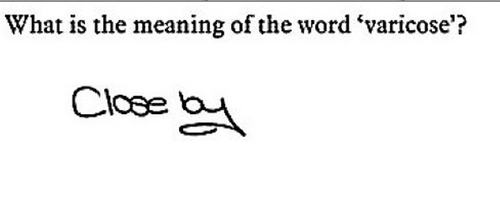
This student’s amusing, and quite possibly unintentional, wordplay could just as easily have appeared in the board games Mad Gab or Balderdash as on an exam paper. Sometimes, if you don’t know the answer and you’re panicking, you just have to give it your best shot. In a pressured situation, this student may well have employed divergent thinking to come up with the answer. This is where an individual produces lots of possible solutions in a short space of time (rather like an internal brainstorming session). Although many of us may not think we’re creative unless we’re artsy, divergent thinking is a form of creativity. And not only that, but according to The Parenting Group, it “is an essential part of everyday life, whether it’s navigating office politics or devising a new social-media network.”
8. Pac-Man
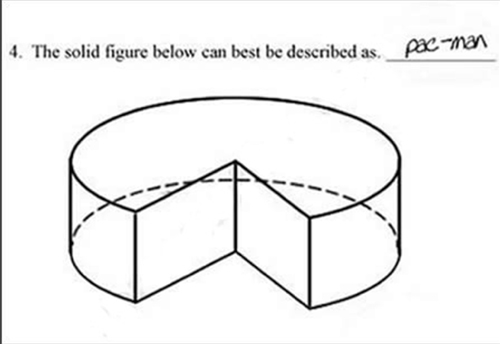
Pac-Man inspired a TV series and a top-ten hit single, so why not exam answers as well? Interestingly, although answers like this might suggest that students are providing unorthodox, witty and inventive (if not downright mischievous!) answers on their test papers, research shows that creativity is actually dropping at an alarming rate among American K-12 students. According to educational psychologist Kyung Hee Kim, Ph.D, “Creativity scores [from The Torrance Tests of Creative Thinking] have significantly decreased since 1990.” Torrance Tests analyze the number and originality of students’ ideas in answer to open-ended questions. And the results of these tests are, say The Parenting Group, “better indicators of lifetime creative accomplishment than childhood IQ.” That’s huge.
7. Tracey is wrong
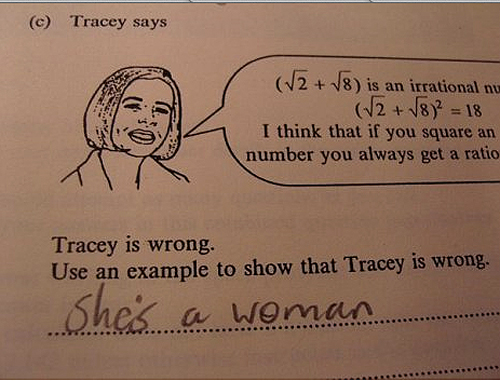
There’s a certain degree of risk involved when it comes to encouraging creativity. Michael Ernst, Associate Professor of Computer Science & Engineering at the University of Washington, says that writing test questions well is absolutely essential. The point of the test is to see whether students understand the concepts, as opposed to simply regurgitating facts and textbook phrases. Being specific about the length of the answer, stating how many answers to circle in multiple-choice questions, and wording questions clearly and concisely are all important. And, says Ernst, encouraging particular behavior on the first test, and thereby establishing a precedent for future tests, will help students pay attention to all aspects of a subject. In this student’s case, we can only assume they hadn’t been paying attention in class and relied on pure naughtiness to answer the question! Such sexism certainly isn’t on the curriculum.
6. Sketch a human body…
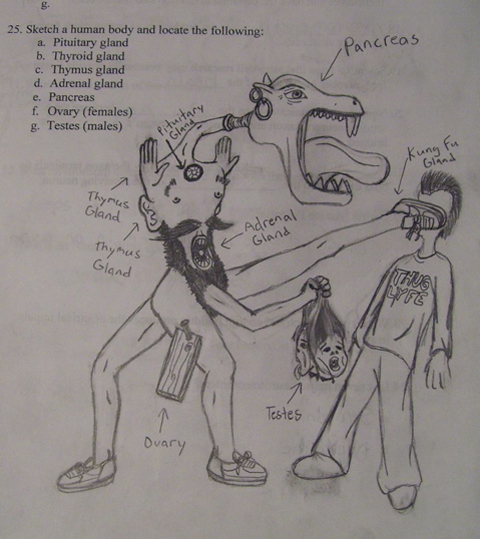
Depicting an animal head pancreas, a Kung Fu gland foot, and decapitated heads as testes, this test answer crosses into the bizarre – if not downright disturbing! Yet although the question itself here seems straightforward, this isn’t always the case. In 2012, eighth grade students in New York were thrown into confusion over a series of questions on a standardized English test. The students were required to read a story and then answer questions about it. The problem was, the story didn’t make any sense. The tale was about a pineapple that has “a trick up its sleeve” and decides to race a hare (in a parody of the fable “The Tortoise and The Hare”). In the end, the pineapple is eaten, because the moral of the story is that pineapples don’t have sleeves. Make sense? Not much. Worse still, the story and questions had been used since at least 2007, with many students in other parts of the US equally baffled and incensed by the passage. Fortunately, the story has now been removed from future tests in New York.
5. Opposites
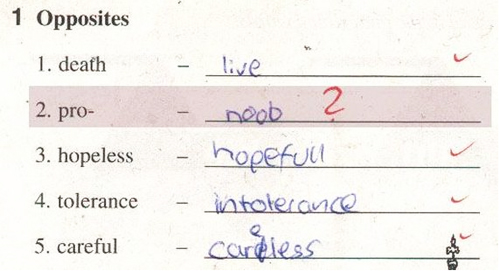
This kid’s teacher must have been a “noob” to today’s slang, or else they deemed the word inappropriate or off the mark. Fortunately for the teacher, this doesn’t appear to have been a standardized test, so the only outcome of this dubious answer would have been a bad result for the student – and not a black mark against the teacher’s name. With the advent of President Bush’s “No Child Left Behind” act and President Obama’s “Race for the Top” program, standardized tests have been placed on a high pedestal. With federal funding on the line, and teachers being labeled “good” or “bad” based on their students’ standardized test results, many educators think matters have gone too far. “If I believed that this system actually could show you who the great teachers were and who the terrible teachers were that would be another story,” says New York school principal Liz Phillips. “It doesn’t say that at all.” Still, there is a flipside. If standardized tests weren’t part of teacher evaluation, New York wouldn’t have gotten $700 million through the Race to the Top competition.
4. Curvy graph
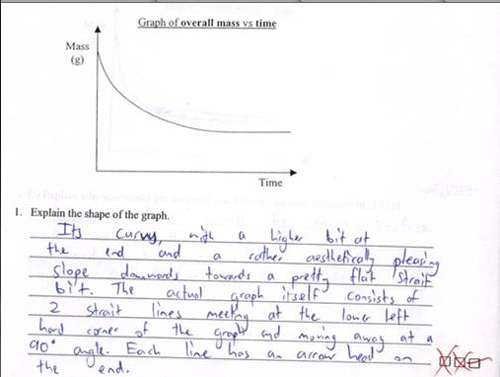
This eloquent piece of writing about a “rather aesthetically pleasing slope” didn’t earn this student much except some crosses; and being unconventionally creative on a standardized test wouldn’t either. Former education lecturer James Atherton says divergent thinking isn’t really assessed in standardized intelligence tests and national exams because they have to be consistent and reliable. Instead, they measure convergent thinking, the ability to bring “material from a variety of sources to bear on a problem, in such a way as to produce the ‘correct’ answer.” However, although convergent thinking is important, it does have its limits and shouldn’t be the exclusive measure of a child’s learning success. Divergent thinking needs to be encouraged too. As clinical neuropsychologist Rex Jung, Ph.D says, “If you’re just a sponge, you may be able to regurgitate facts, but you can’t combine them in novel and useful ways.”
3. The best solution to overpopulation
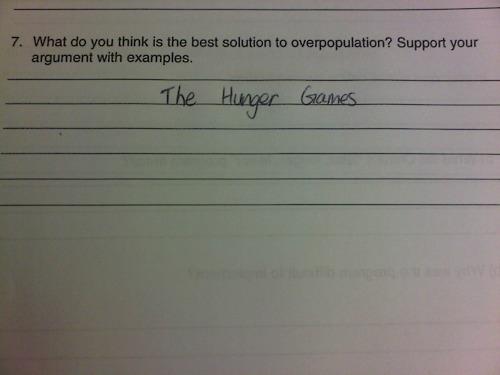
Running televised gladiatorial events to solve overpopulation isn’t exactly a useful or novel suggestion, but you have to admit, it is rather amusing. Many argue that fresh thinking is getting harder to come by as schools focus on drilling for tests. With schools and teachers struggling to maintain their credibility and funding, this shift in focus is understandable – but it can take away the opportunity for students to develop strong creative learning skills. As The Parenting Group says, good teachers are creative themselves, encouraging students to come up with their own ways of doing things and expressing their ideas. Maybe if this student had offered a legitimate argument for their morbid suggestion, they would have gained full credit.
2. Find “x”
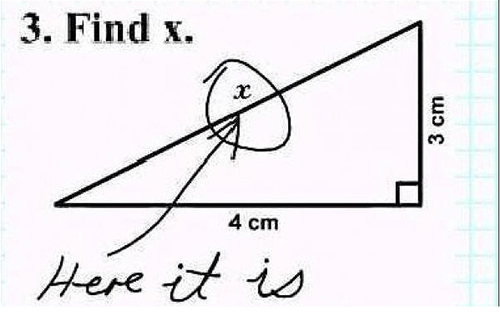
It’s hard to argue with this answer. After all, it’s so correct – and yet, at the same time, so wrong. Obviously, getting fancy in math tests probably isn’t the best outlet for creativity. So what is? Well, brainstorming, artwork, keeping a journal, free writing, and visual mapping all stimulate divergent thinking. And when it comes to research projects, giving students scope to choose their topic and way of presenting it encourages them to have faith in their own style and approach while also, with any luck, offering them more motivation to do well. Researcher Denise de Souza Fleith says that teachers can foster creativity by “not imposing too many assignments and rules on students, giving students choices, providing students opportunities to become aware of their creativity, and accepting students as they are.”
1. The diagram below best illustrates…
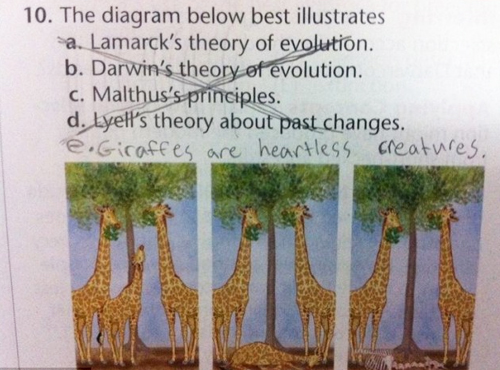
In the end, teachers will always come across the occasional hilarious or ridiculous answer to a test. It’s just hoped that this will bring some well-deserved humor into their lives. The good news, of course, is that great teachers really do make a difference, no matter the current debate on standardized tests or methods for how best to measure learning and effective teaching. A study by economists at Harvard and Columbia universities discovered that a strong teacher can significantly improve a student’s quality of life – and income – in the long term. All the hard work preparing lessons, grading, and putting up with the kind of quirks and sassiness we’ve seen here really does make an impact. And it’s probably easier to appreciate such “innovative” responses to tests when you know that those kids may actually be employing some crucial creative life skills. Even so, we’ll never think of giraffes in quite the same way again.